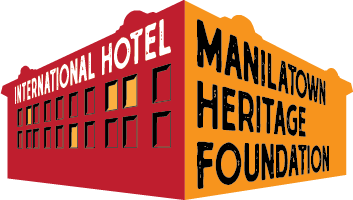Manilatown Archives presents
Philippine Mythology
Drawings by
Jeanette Gandionco Lazam
Exhibition: November 2, 2024 — January 31, 2025
Philippine Mythology
The Cultural Beliefs & Mythology of Pre-Colonial Philippines:
The Myths,The Magic, The Legends & The Creatures
Drawings by Jeanette Gandionco Lazam
Artist Statement
“You cannot understand, self-educate, self-study, and learn about a people’s history and culture(s) unless you include their Mythology and Beliefs into the equation.”
According to noted historian Jose Antonio Custodio, in pre-colonial times in the Philippines, “The Philippine definition of indigenous is not similar to how we know other countries tend to define it.” Below he notes:
There was no massive settlement of Europeans in the Philippines unlike in the Americas and Australia.
There was no massive decimation or extreme marginalization of the native population which happened also in the Americas and Australia.
The Indigenous population in the Philippine colony thrived and increased to the tens of millions in the centuries that followed and despite having adopted colonial or other foreign customs still retained their physical features and languages.
Therefore, in pre-colonial times and even decades after, the Philippine population in its entirety can be considered Indigenous with varying belief systems, languages, and customs that still thrive today.
My feeble attempt to capture Philippine Mythology, which in many ways reveals their belief systems rooted in the natural world brings to life those mythological deities and creatures our parents told us about.
Philippine Mythology also ties in with how and why the Filipino population during pre-colonial, colonial, and present-day understandings, endeavored to explain natural phenomena such as typhoons, floods, drought, sweltering heat waves, and the mystical creatures such as the Aswang, Mumu, Bakunawa, and Agta that scared little children and even adults.
I hope that everyone who visits the Philippine Mythology exhibit will walk away with more questions and a yearning to uncover how and why Philippine Mythology shaped Filipino history and belief systems.
Jeanette Gandionco Lazam
Artist
DEITIES
All Drawings 9" x 12" Pastel on paper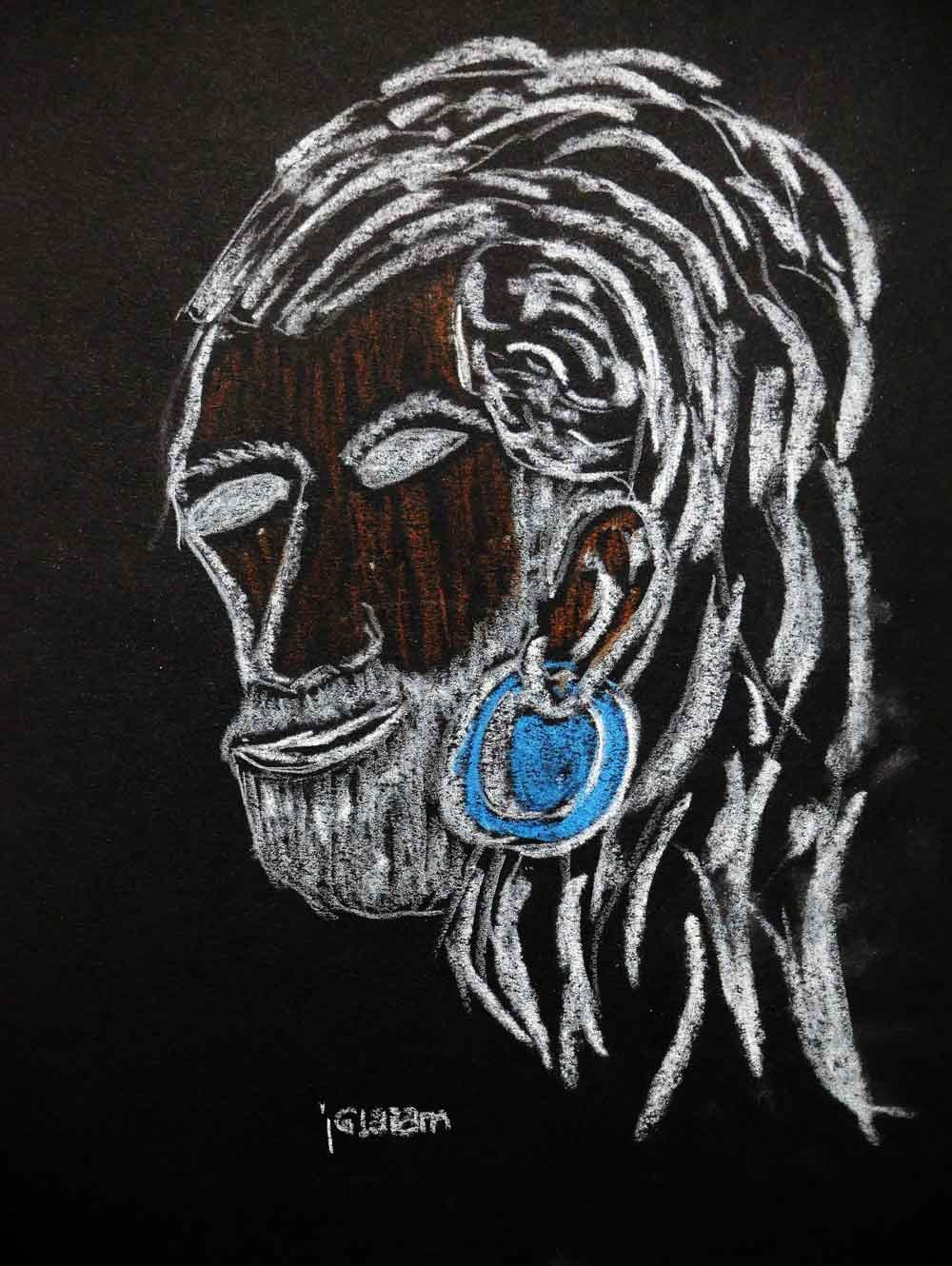
Bathala

DumaKulem
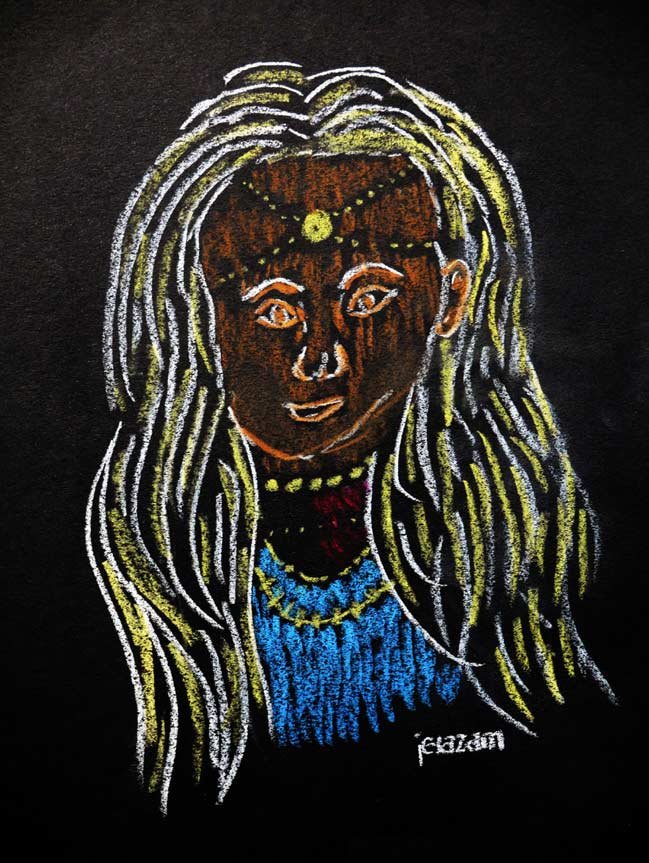
Anagolay
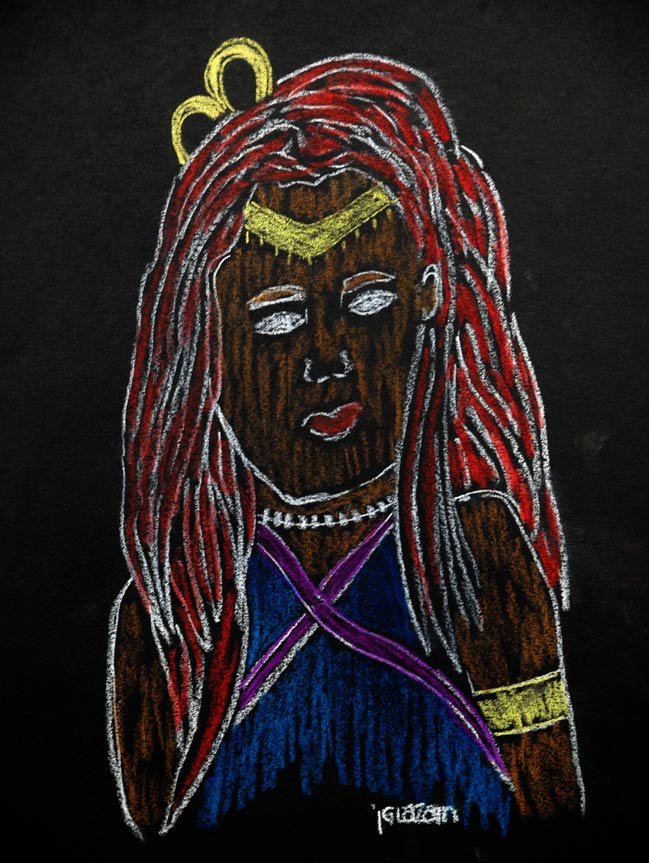
Anitan-Tabu
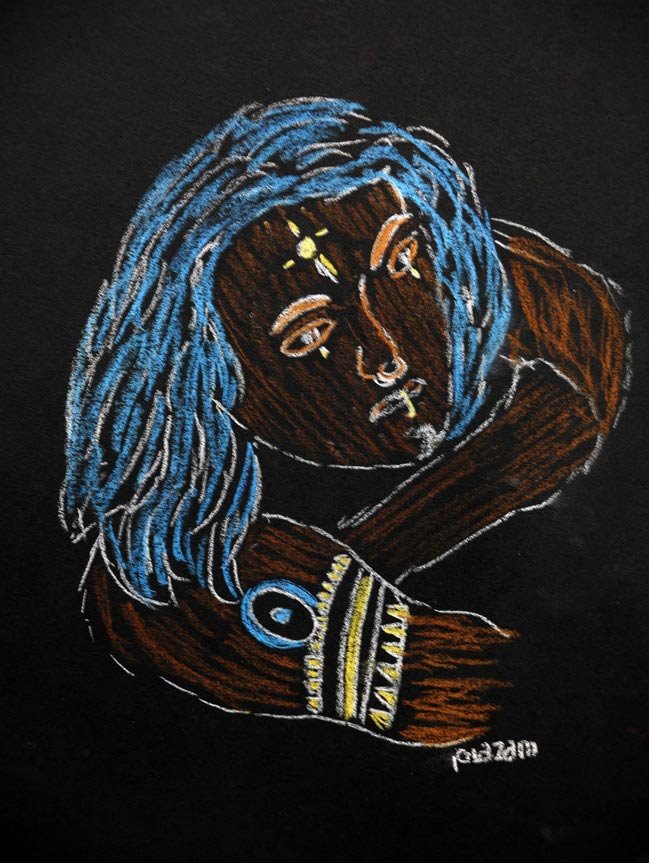
Apolaki
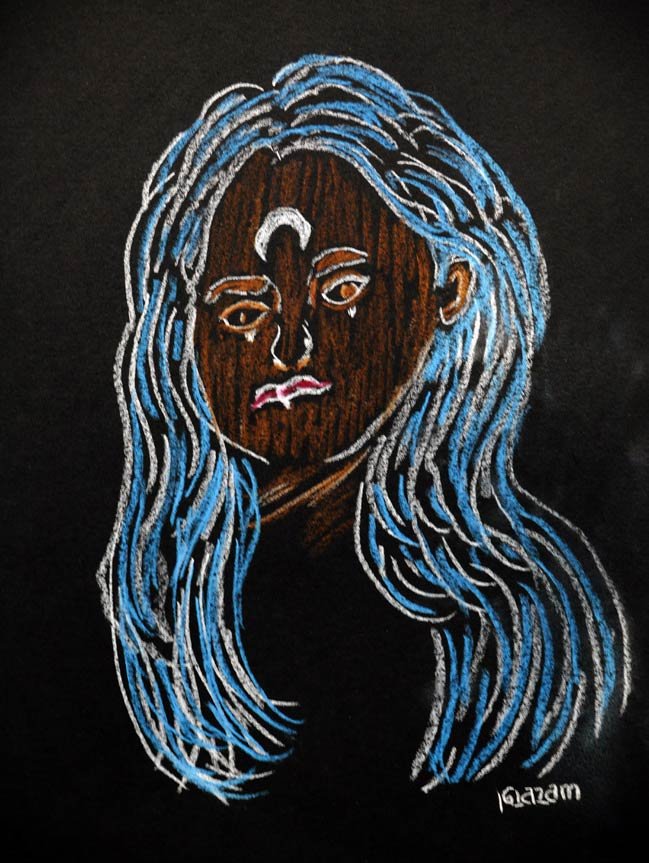
Mayari
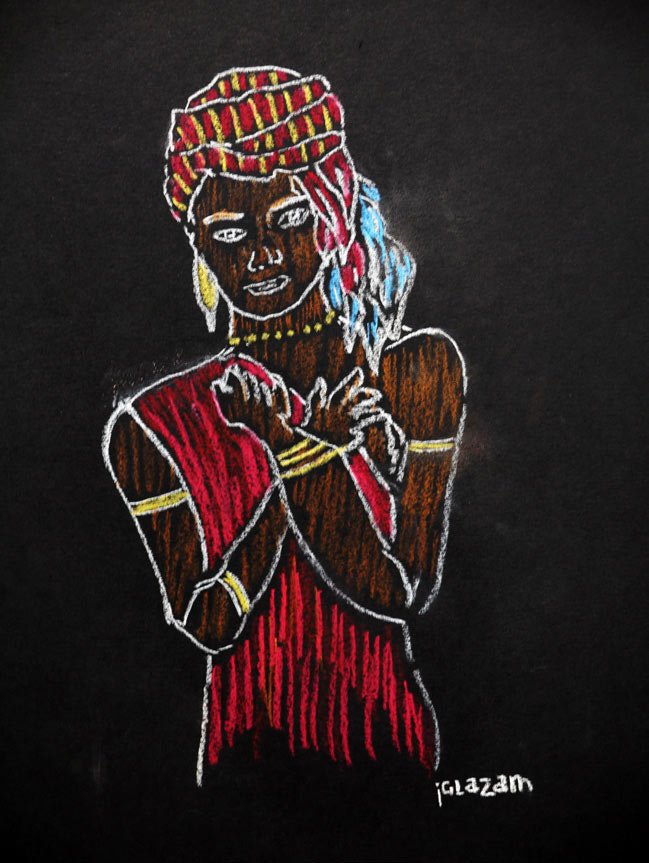
Laka Pati
Pre-Spanish Colonialism - In the Beginning
Ages before the appearance of Spain in Southeast Asia, the (now known as) Filipinos had commercial, political, and cultural relations with India, China, Japan, Arabia, and Malaysia.
Unfortunately, many facts about this early period of Philippine history are still unknown so our comprehension of it is rather vague. Historical research in recent times, however, aided by archeology, ethnology, and folklore has given us concrete, although fragmentary, facts which cast some light on the opaque dawn of Philippine history.
The history of the Philippines is believed to begin at least 709,000 years ago as suggested by the discovery of Pleistocene stone tools and butchered animal remains associated with hominid activity. Homo luzonensis, a species of archaic humans, was present in the island of Luzon at least 67,000 years ago. The earliest known modern human was from the Tabon Caves in Palawan dating about 47,000 years.
Neuritis groups were the first inhabitants to settle in the prehistoric Philippines. The term Negrito (often considered a misnomer) refers to several diverse ethnic groups who inhabit isolated parts of Southeast Asia and the Andaman Islands.
Ancient Austronesians were also animistic. The spirits in their belief structures were collectively known as ANITO, derived from Proto-Malayo-Polynesian and Proto-Austronesian. ANITO can generally be divided into two main categories: The Ancestor Spirits (ninuno) and deities and nature spirits (diwata). Generally, these indigenous folk religions are referred to as ANITISM or the more modern and less Tagalog-centric DAYAWISM.
While the foundational base of beliefs can be formed from an understanding of Austronesian Animism, other religious influences contributed to the sculpting of very unique religious structures among each ethnolinguistic group throughout the archipelago. The folklore narratives associated with these religious beliefs constitute what is now PHILIPPINE MYTHOLOGIES, and is an important study of Philippine Cultures. -Jordan Clark, Founder, Aswang Project
Stories of Philippine Mythology
DUWENDE is often an old man with a body the size of a child and wearing a Salamat (a native hat usually worn by farmers). DUWENDES are known mainly for their magical ability to make someone who hurts or offends them to suffer with unusual diseases ranging from skin rashes, inflammation and fevers that can be cured by any medical intervention. DUWENDE also bring enchanted gifts to their moral friends.
LAMPONG a dwarfish shepherd of wild animals among the Ilongot of Northeast Luzon. The Ilongots and Ilokanos call him LAMPONG. He is a short old man of the woods and fields. He is a shepherd of wild deer.
MUMU is a malevolent spirit that lurks in darkened, shadowy corners waiting to snatch children away from their families. It is a ghost or spirit that has unfinished business in our world, was not given last rites, or has not yet accepted their death. In Northern Luzon, the MUMU changes into a spirit that feeds on children or takes their souls. In Pampanga, it is known as the PUGOT-MAMU—a horrific headless being that swallows children through its serrated neck.
KABALAN hails from the province Catanduanes in the Bicol region. They are described as horse-like (with 4 legs like a centaur). Hairy from head to toe, with a human face/human likeness to the face. It is said they live in trees and are angered when homes are disturbed. The creatures are merciless though and will curse the offenders with sickness and bad luck until the end of their days.
MANTIYAK (The Vengeful Spirit from Mindanao) is a spirit with a slit in her belly with her unborn child inside. She considers men Asher enemy. The spirit thinks she could have lived had she not gotten impregnated by a man. She does her revenge by attacking men at night and ripping off her victim’s penis, causing them to bleed out.
MHENMAD THALON (The Male THALON) is an obscure creature in Philippine Folklore. From its origins in Zamboanga Del Sur, its myth has not spread to other parts of the Philippines. The THALON is a dog-like creature with the feet of a human. It’s 4 human feet point backwards and it walks the way a normal dog would. Its face can range from human to beast-like. It’s appearance is the same whether female or male. The THALON usually looks for its prey as soon as the sun goes down, or by 5 pm. If it is dark outside the Thalon will not be seen, but it’s presence will be felt when it’s near. It is only when the THALON is near that the person can see it. The THALON makes a distinctive “Kao Kao” noise.
THE IMPRISONED NAGA (An Explanation of the Milky Way—in Samal myth the Milky Way) is a gigantic trapped dragon (referred to as Naga). The legend goes that it was put in the sky when a couple prayed to God to save their lives from the terrible beast. At the end of days, it is said that the dragon will be freed and will devour all those not faithful to the Almighty.
KATAW is the Visayan name for “sirena.” Variously called sirena, KATAW, DUYONG, and MANATEE in the legends, mermaids are generally described as beautiful women, with long curly black hair and black eyes. They are half woman and half fish. She lives in a beautiful house under the sea or beside a river, lake, or a waterfall. She sits on a rock drying her long hair. She sings a sweet, sad song as she sits there. She makes the fisherman row his boat to her. Then she sinks the boat and gets him.
THE SUN/MOON EATER is a common motif of the sun/moon eater around the Philippine Archipelago. This is a being that seeks to consume the sun or moon, causing solar or lunar eclipses. Among these are the famous Bakunawa in the Visayas, the Arimaonga of the Maranaos, the Tambanakano of the Managua’s, the Tambanakaua of the Manobos, the Laho of the Tagalogs, the Sawa of the Ati in Panay, Kedu of the Maguindanaons, Okinawa of the Ilokanos, the Minokawa of the Bagobos, among others.
LAHO
MINOKAWA
KEDU
LA’WU
LA’WU is a giant creature that looks like a mixture of a serpent and a bird and has some crocodilian aspects. He has claws and fangs and is bird like with wings and a fierce face that is Crocodilian. The LA’WU swallows the sun or moon and Kapampagans believed that if the sun or the moon were able to fight their way out of LA’WU’s stomach (Mitdas ya atian ng La’was) or partial eclipse would happen then there would be no famine and there would be a bountiful harvest.
MANLALAYOG (The Long-Haired Wraith-MANLALAYOG) is sometimes spelled MANLALAYUG. They are women covered with hair from head to toe. Their hair grows longer and more wire-like at night. She kills people with her hair, this is done by forcing her hair in all offices of her victims body.
TIGBANUA (The Terrible Ogre Bagobo Myth) is described as having one eye, with tall, lean bodies and long necks that they twist to see what’s behind them. Their hair is disheveled and their one eye is either red or yellow. They have flat noses and pointed teeth, their feet are over-sized and usually their skin is covered in muck and grime. They prefer to stay in jungles, caves, or rocky areas. Stories have it they hunt in groups and attack a victim, dismembering the poor soul and tearing them with their claws.
The TIGBUNUA are afraid of dogs, despite their large and fearsome demeanor.
AGTA (also known as the Kapre) is often attributed to the Eastern Visayan provinces are Samar and Leyte. Its reach also extends into Masbate and Bohol. The Agta of East Visayas are said to live in mangroves and swampy places. The most frequented home of the demons is the balete tree.
MANTIW are the thirty-foot forest spirits in Iloilo, Panay is often spotted whistling while roaming the wide open fields, or leaning against coconut and buri trees. Despite being commonly reserved and peaceful in nature, the MANTIW are easily offended when a human attempts to whistle along with them. As a result, it will grab the whistling human it finds a nuisance, carry them off to the tallest coconut tree, and abandon them on the very top without means of climbing back down.
BUNGISNIS (Philippine Cyclops) is described as a large strong man who is always laughing. His name is said to be derived from the Tagalog word, “ngisi” (to show teeth). He is also said to have an upper lip so large that when it is thrown back, it completely covers his face. His strength is indicated by his reportedly seizing a carabao by the horns and throwing it knee-deep into the Earth.
ALAN is the deformed humanoid/avian—a mysterious race of bizarre and grotesque beings. The elongated fingers and feet are said to point backward, which they use to hang upside down from trees.
Aswangs
All Drawings 17" x 24" Pastel on paper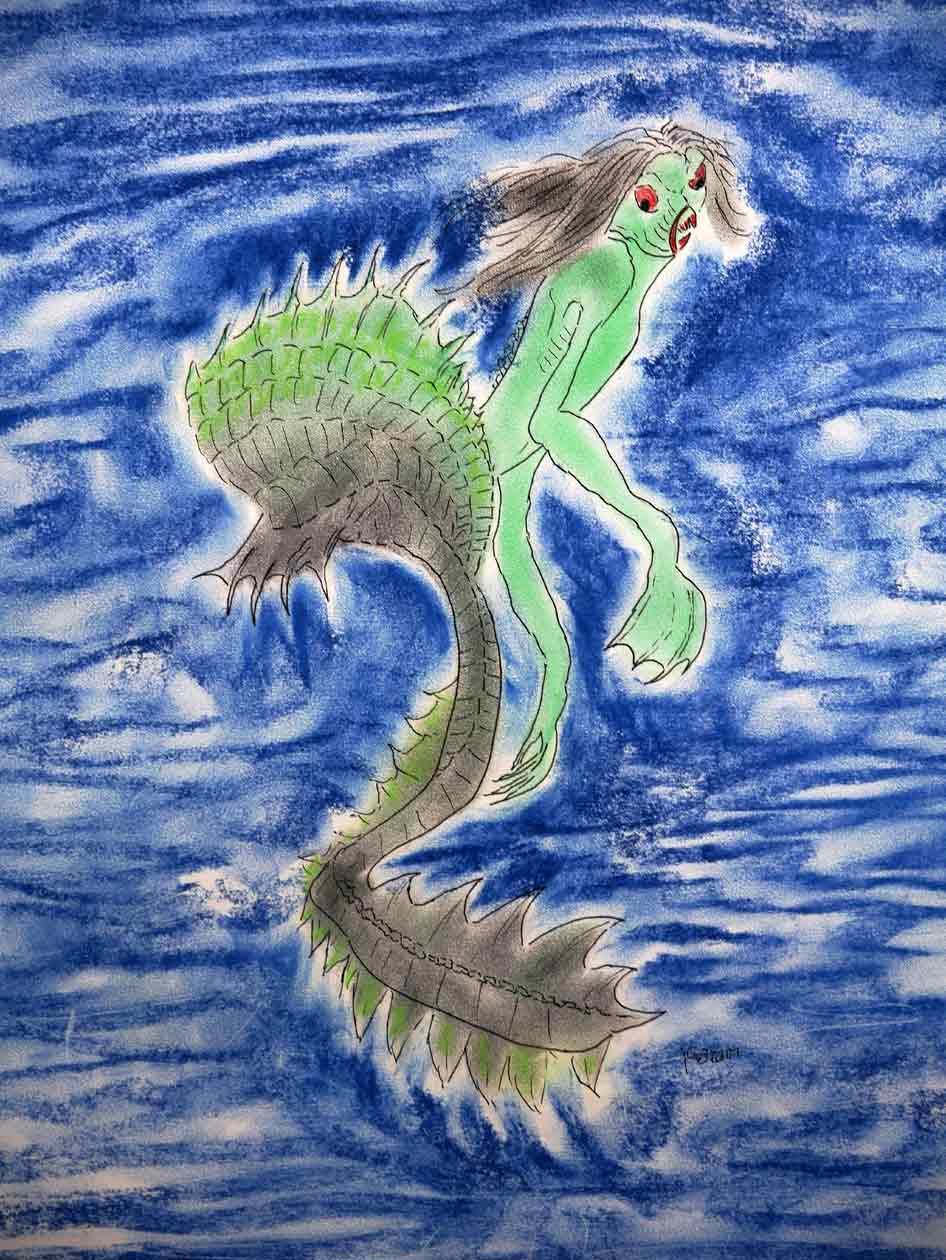
Aswang 1
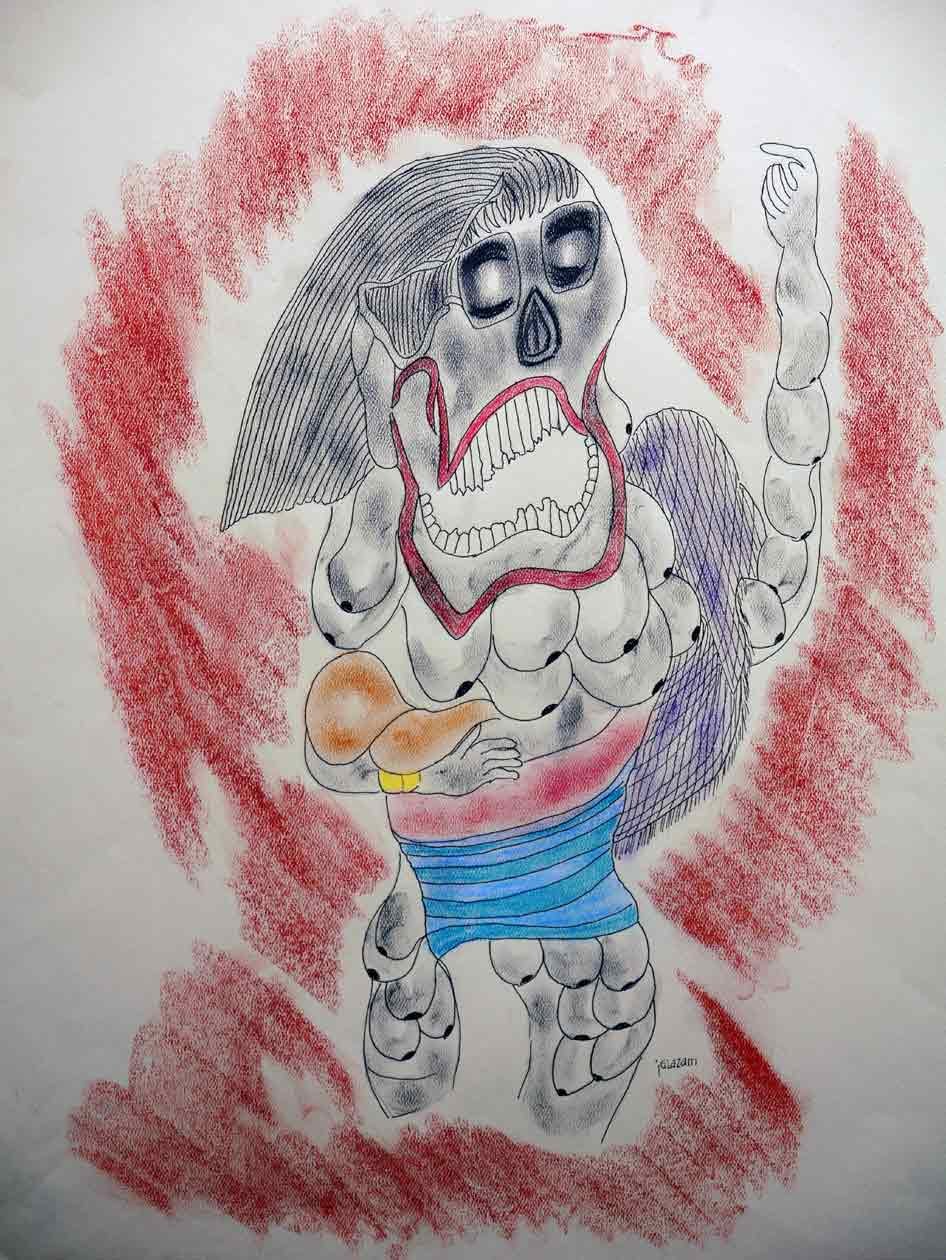
Aswang 2
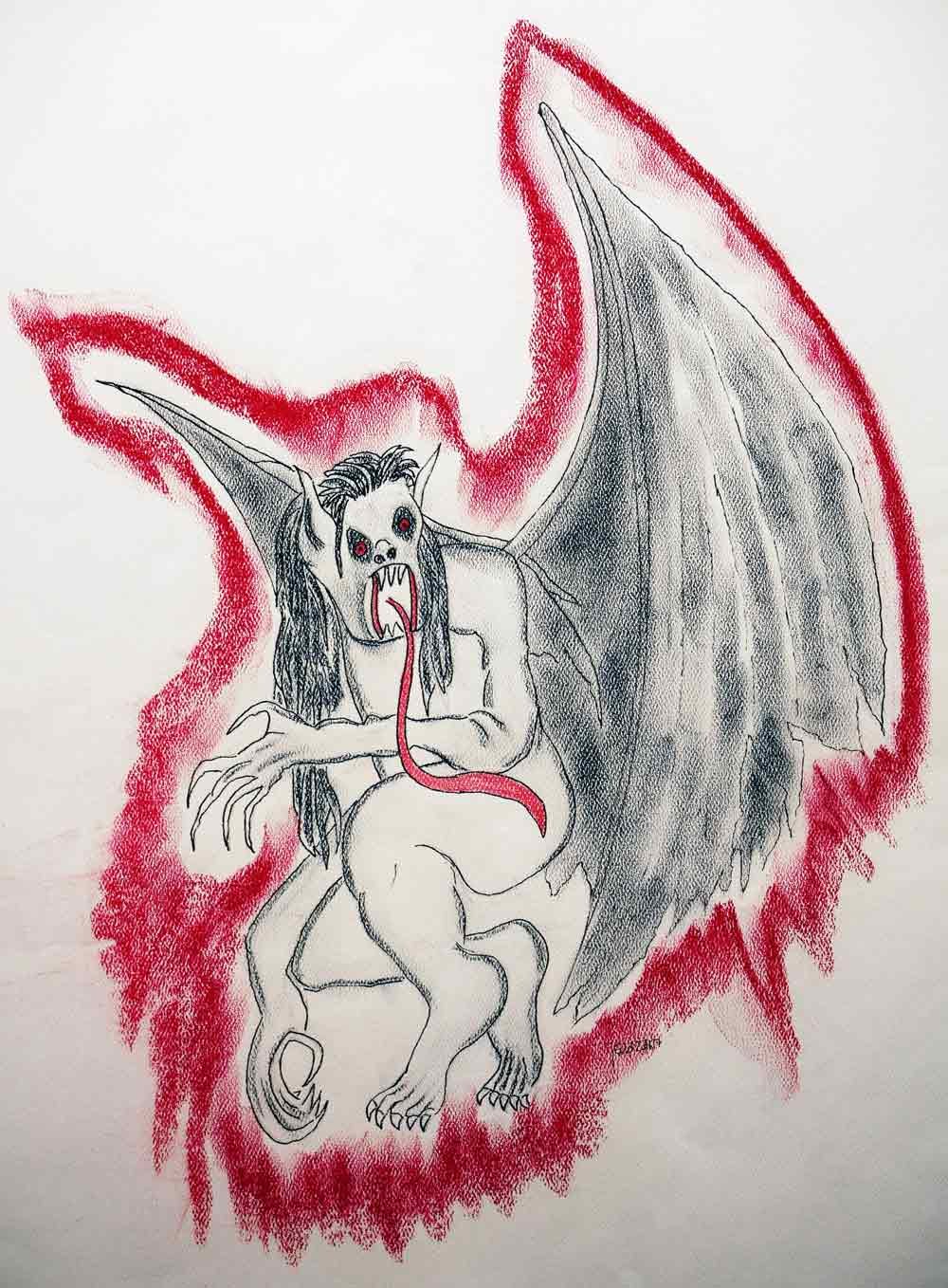
Aswang 3
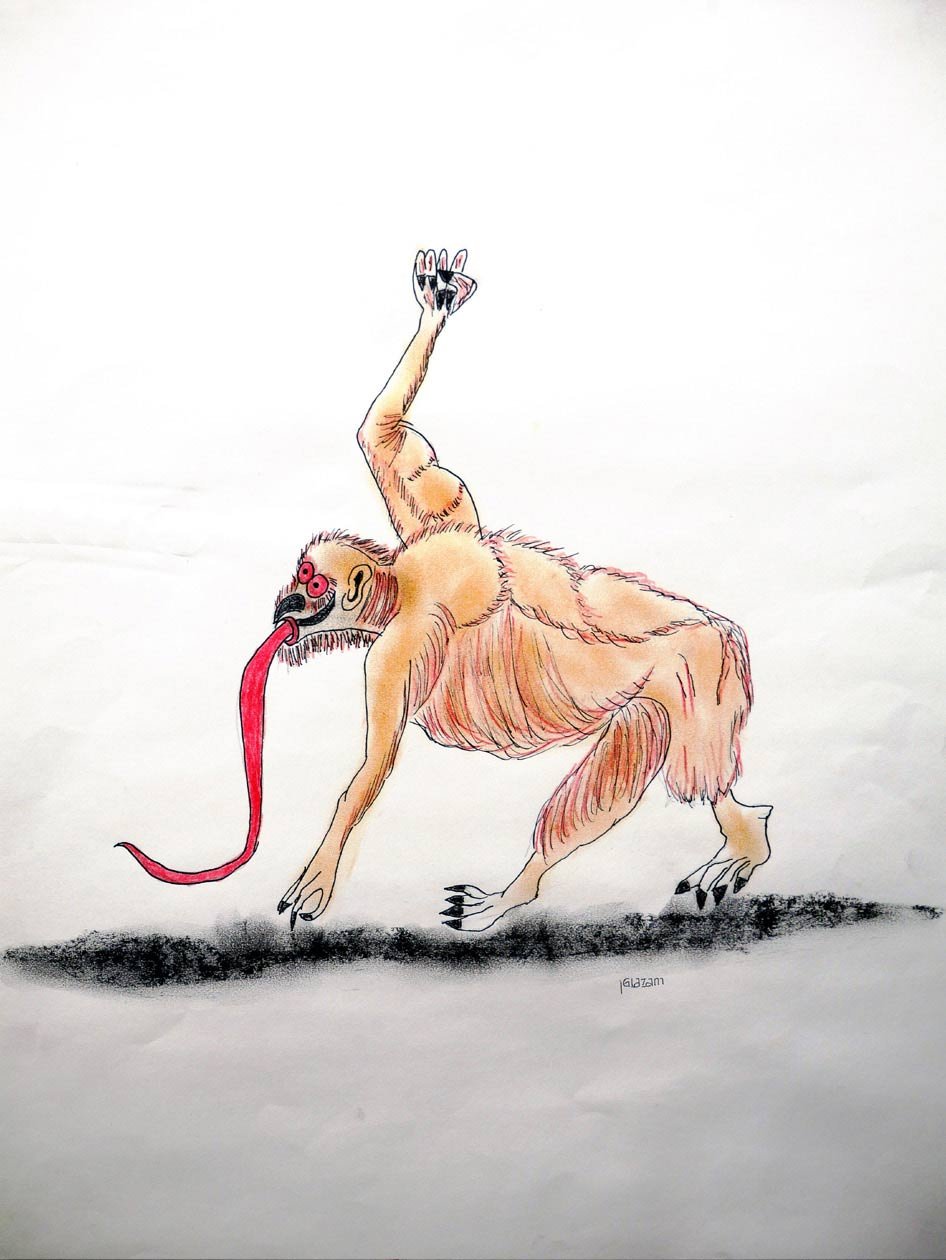
Aswang 4
Folklore by Philippine Regions
In recent years, the term babaylan has dominated the conversations regarding historical and modern indigenous narratives. There is good reason for this. From the closing decades of the 16th century up to the early 1900s, Panay Island in the Western Visayas had its historical timeline dotted with uprisings led by the babaylans against the missionaries. Friars assigned in different parts of the island were poisoned or speared to death.
The area of the Visayas also saw the babaylan evolve from a female position, to gender nonconformity, and ultimately becoming a predominately male role. The available historical documentation has been used in comparison, and to contrast, modern social meanings, making the babaylan a powerful symbol and a fashionable term.
TAGALOGS
KATALONON - The Spanish documented the KATALONON as men and women shamans of the old religion. They were responsible for healing the sick, rendering prayers, offering ceremonies to the idols, and making treatments and cures.
BAYOG OR BAYOGUIN - Regarding sacrificing of animals, the Spanish noted, “All this is administered by a priest dressed in female garb. They call him BAYOG OR BAYOGUIN.
Although these Indians have no temples, they have priests and priestesses who are the principal persons of their ceremonies, rites, and omens, and to whom all the important affairs are entrusted.
ALBULARYO & MANGKULULOP - The ABULARYO are general practitioners of folk medicine. They are not specialists in the sense of limiting their work to one aspect of healing, although their forte is the use of medicinal plants. Most, know how to diagnose, take the pulse and perform the curing ritual if there is no specialist on hand. The ABULARYO may call for the MANGLULOP to perform the ritual. This is not because the ABULARYO does not know how to do the ritual but because of the belief that the MANGLULOP has greater power than anybody else in controlling the disease as well as influencing the environmental spirits to follow its Bidding.
MANGHIHLOT are specialists in fractured or broken bones, sprains, and other kinds of discomforts having to do with muscles and bones. Each MANGHIHLOT has their own system of locating the discomfort. The second group of MANGHIHLOT is made up of those who use fresh banana leaves, especially from a species known as saba.
MAGPAPAANAK are better known as HILOT. The term HILOT is derived from the activity used in the healing process. They are men or women who are skilled in assisting mothers in the delivery of their babies.
MAGLULUOP are specialists in deboning illness through ritual, known as luop. Since the MAGLULUOP can also be a ALBULARYO.
BIKOL
BALYANAS when calamities befell ancient Bikolano, such as typhoons, epidemics, etc., and believing ASWANG to be the author of all the miseries, they would endeavor to destroy its spell by performing a ritual called hidhid. This was performed on sick people who were suspected to be suffering through the malice of ASWANG. In the hidhid the BALYANA would put some buyi leaves and rice grains above the head of the sick. The BALYANA go around the person several times, dancing and performing various contortions as well as mumbling secret phrases to exorcise the ASWANG.
ASOG are the people of BIKOL would hold a thanksgiving ritual called atang that was presided by an effeminate priest called an ASIG. His female counterpart, called a BALIANA assisted him and led the women in singing what was called the speaking, in honor of the GUGURANG (supreme deity).
PARABULING - The Paula’s ritual is carried out in order to supply are the spirit world, particularly the engraftment or AGHOY who inhabits the place where a house is to be built, to protect the workers from harm and to accept the disturbance that may ensue in account of the construction work on the premises. The Paula’s is administered by a PARABULING or faith healer who is accustomed to such activities being a friend or nemeses of the spirit world inhabitants.
PARABAWI - When a bad spirit enters the body of a person, this person gets sick. S/he suffers from high fever and assumes the personality of the spirit inside them. Hence, his/her voice, his/her words, and his/her knowledge about things may amaze the people around he/she. To bring this person back to hers/his world, they need a PARABAWL.
VISAYAS
BABAYLAN also known as DAILAN, the BABAYALN was mediator between the gods and the people and healer of the body and spirit. Mostly played by women, the BABAYLAN’S role bordered on the political as well, being a close advisor to the date in almost all matters concerning religion, medicine, natural phenomena, etc. The term BABAYLAN is most used on Panay, Negros and other areas of Central and Western Visayas. The Hiligaynon, BABAYI for women shows a close relation to the term BABAYLAN. In Kinaray-a, an ancient language still being spoken in Antique and some interior towns of Iloilo, BAYI and BAY/AN are the terms used. In Kinaray-a, BAYI is also used to refer to one’s female grand elders. BABAYLAN then implies an age-old tradition embodied in the concepts basic to the culture and society of Panay.
MA-ARAM (Panay) - the MA—ARAM practice of Panay among the Karat-a is a phenomena referred to as BINABAYLAN by non practitioners as well as those less sympathetic to the practice. In Barrio Marit where this phenomena exists, practitioners prefer to be called MA-ARAM due to the prejorative connotation attached to the term BABAYLAN by non-BINABAYLAN believers. While this practice is the same role as the historical BABAYLAN, in modern times it is mostly male practitioners.
ASOG (Leyte & Samar) - The ASOG considered themselves more like women than like men in their manner of living, or going about, or even in their occupations. Some of them applied themselves to traditional women’s tasks. In dress, although they did not wear petticoats (these were not worn by women in ancient times either) they did wear some Lambon. It is a kind of long skirt down to the feet, so that they were recognized even by their dress. Unlike female shamans, they neither needed to be chosen nor did they undergo initiation rites. However, not all ASOG, trained to become shamans.
Spanish colonization, since the indigenous of Cebu had direct contact with the Portuguese explorer, Magellan, and on-going indigenous practices before colonization. The PANAMBALS cover natural and supernatural illnesses using a wide range of methods. Two common methods used are herbal medicine and orasyon, healing prayers deriving from bible equivalency called LIBRITO.
MANANAMBALS treat major and minor ailments. These ailments include but are not limited to: headache, fever, cold, toothache, dengue fever, wounds, infection, cancer, intellectual impairment, and other illnesses thought to be caused by supernatural creatures.
DIWATERO and MAMUMUHAT are the ones who cure illnesses specifically caused by supernatural beings and buyable. They are a medium who acts as intercessor between humans and spirits.
TAMBALAN (herb doctor or medicine man) is, even in ern Philippine society, a respectable Personality. Among the lower class the TAMBLAN is more trusted than the district health inspector who regularly visits their places. In folk-belief, the TAMBALAN is believed to have supernatural powers to contact and control the spirits. Since it is believed that the healing power of the TAMBALAN a is supernatural gift which might be lost if money is taken for the services rendered, the medicine used by them is cheap and is often without charge.
MANG HIHILOT & MANUG LUY-A (Negros Occidental) are considered traditional healers. People usually come to these healers if they are experiencing illness.
MANUGLUY-A is very familiar with rituals, modalities of diagnose and healing, prayers, whisper (bulging) and roasting, and the use of herbal medicinal plants. They are familiar with the different spirits causing Illness, which are dwarfs and nunos.
Other names for healers in the Visayas, including Samar, Leyte, Cebu, Bohol, and among Bisaya speakers in Northern Mindanao are:
BAYLAN (also BAYLAN, bailable, bailie a, BAYLAN)
KATOORAN ( also catooran)
MAKINAADNANIN, ANITERA (also anitero)
MANANAMBAL (healer)
HIMAGAN (healer)
SURUHANO (herbalist)
MANGHUHULA or MANGHIHILA (Devi ER)
MANANABANG (midwife)
CORDILLERAS
MAMBUNONG, MANSIPOK, MANKUTOM (IBALOY & KANKANA-EY)
This office is usually held by wise old men experienced in the life and ways of their people. The MAMBUNONG (the maker of prayers) presides in all the feasts requiring the recitation of bunong or prayers. Anyone can become a MAMBUNONG as long as he learned the correct procedures sufficiently well to approach the deities and spirits for them to grant his intercessions or to effect a cure and good fortune. One learns the procedures and prayers associated with each ceremony through constant listening and observing, or through direct instruction of a MAMBUNONG.
These priests are generally classified into two classes. One class is composed for most part of women, performs rituals reserved for special ceremonies; and the other, composed of older and experienced MAMBUNONG, performs familiar rituals. The latter are called MANBAHI and usually preside in special feasts afforded only by the BAKNANG.
MUNAGAO & MUMBINI (Ifugao)
Women priests are called MUNGAO, while male priests are called MUMBINI. Oftentimes a person becomes a priest through inheritance from a father priest, or through a near relative who teaches the rites during the instruction period, as well as during the consecration of a new Priest. In Morse modern times, an Ifugao MUMBAKI is a kind of religious specialist who can perform various healing rituals as well as engage in spiritual practices. This is why they are occasionally called witch doctors. Nowadays, such shamans practice alternative medicine such as chiropractic, homeopathy, and also faith healing.
DORARKIT(Isneg)
The Isneg shaman or DORARKIT(sometimes called ANITOWAN) is always a woman. The functions of the DORARKIT are numerous and varied. She determines, chooses, collects, and distributes the tan in or amulets, which play such an important role in the life of an Isneg, although not all of these come under the jurisdiction of a single shaman. She is the universally accepted physician and surgeon in all kinds of sickness.
The position of the shaman is not hereditary among the Isneg. To be considered a DORARKIT, it is sufficient for a woman to have been consecrated by another shaman, but such consecration is absolutely required.
ALOPOGAN (Tingguian)
The superior beings talk with mortals through the aid of the ALOPOGAN, known individually and collectively as ALOPOGAN. (She who covers her face). These are generally women past middle life, though men are not barred from the profession, who, when chosen, are made aware of the fact by having trembling fits when they are not cold, by warnings in dreams, or by being informed by other ALOPOGAN that they are desired by the spirits.
MANGALISIG, MANGANITO, MANDADWAK (Kalinga)
The priesthood is almost entirely in the hands of women. Entry into it always in answer to a “call”, and is in a sense, compulsory; the woman begins to sleep badly, has many dreams, grows thin, lacks appetite, believes that her soul has married an ANITU and that she can extricate herself from the condition only by becoming a priestess (MANGAALISIG). Or she may become conscious of the call from getting stomach upset after she has eaten foods that are taboo to priestesses: eel, dog, certain fish, meat of a cow (not carabao). She is said to be taught the rituals by the gods themselves, not by the older priestesses.
The medium, healer or priestess also goes by the names MANGANITO or MANDADAWAK.
MABAKI (Ikalhans)
Among the Ikalhans, the MABAKI takes care of all the ritual proceedings. It is he who invokes invitations to the ancestors and spirits (ampahit) to join the celebration and bring blessings.
INSUP-OK ( Bontoc)
Every individual or household has the power and knowledge to intercede with the ANITO, although often times, the seer or medium (INSUP-OK) is called to heal afflictions caused by malevolent spirits. In every ceremony the spirits are invited to take part in the animal sacrifice through Kapya, a prayer composed extemporaneously by the presiding INSUP-OK.
PALAWAN
BABAYLAN (Tagbanua)
The Tagbanua BABAYLAN have numerous duties and influence upon the everyday social activities of the people. They select ritually favorable clearings, placate environmental deities, interpret dreams, provide charms for hunting and fishing, and treat all types of serious illness.
During the familial bilang ceremonies any adult can invoke the spirits of the dead. But the many deities which appear during the “pagdiwata” rituals can only be called by the BABAYLAN. They guide the interaction of the living with deities as well as with the dead.
BABALIAN (Batak, Tanabag)
In traditional Batak society shamanism is the perogative of males Specialsts known as BABALIAN. Shamans contact spirits during trance, predict future events and are said to possess the gift of clairvoyance. They administer the therapeutic remedies and supervise collective subsistence practices, as well as ceremonies to re-establish the cosmological balance.
BALJAN (Liwland Palawan People)
A male ritual specialist, BALJAN, conducts rituals, but many other people both male and female, perform ritual dances with or without trance. Everywhere amongst liwland Palawan people, gong beating is synonymous of ritual calling of the deities, diwata, or “Powerful Ones”, Kawasa.
During cleansing rituals, the BALJAN is responsible for what is happening, and he should be able to fight and drive away the galap or tandajag (giant serpent) before it swallows the whole country or makes it disappear in a hole or a lake where pit would sink with all its denizens.
CREATURES
All Drawings 9" x 12" Pastel on paper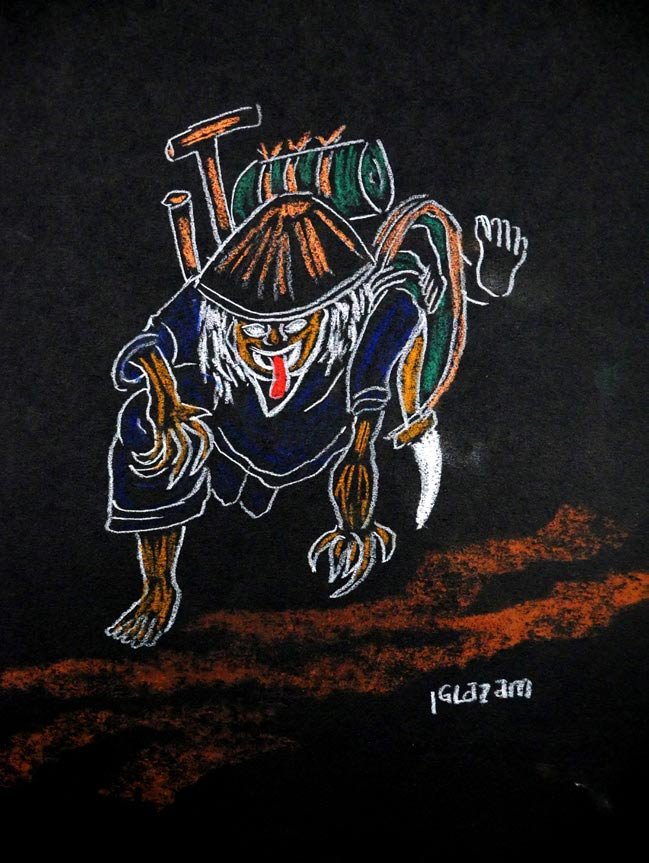
The Bal-Bal
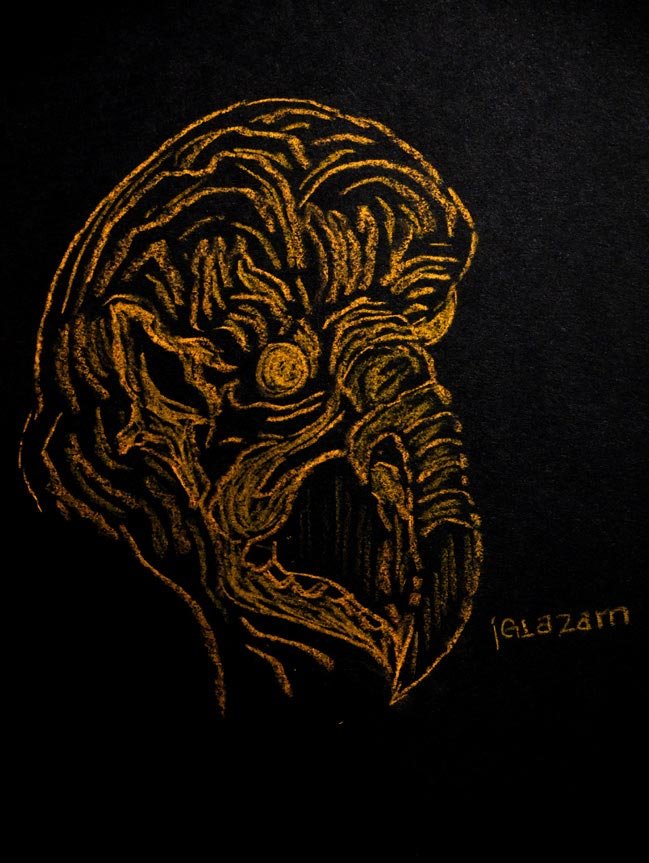
The Alan
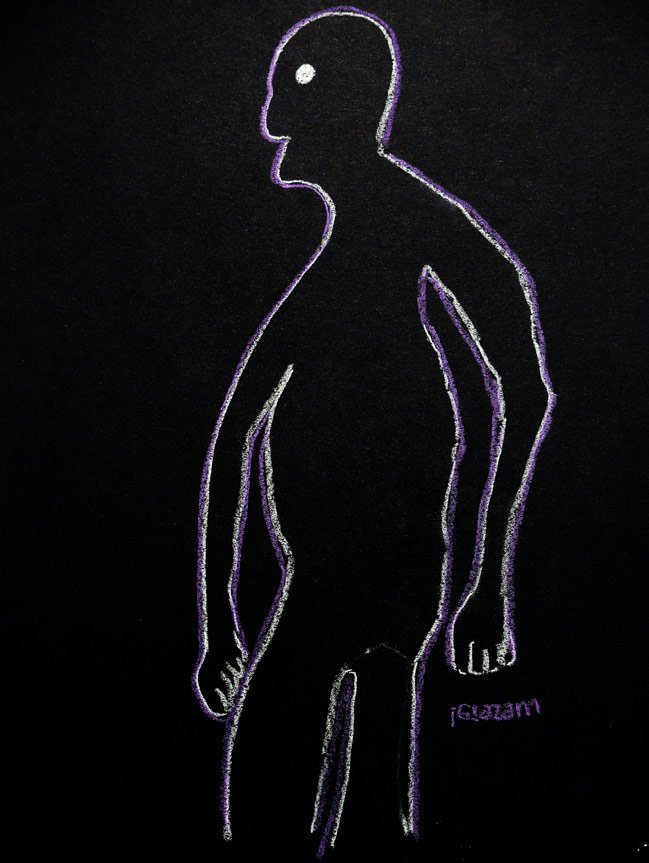
Mantiw
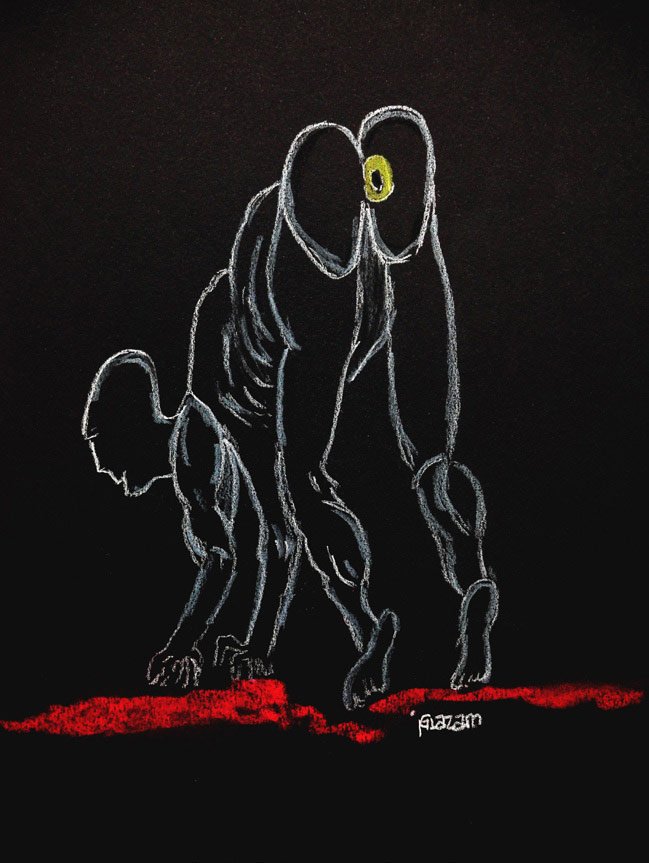
Shirime
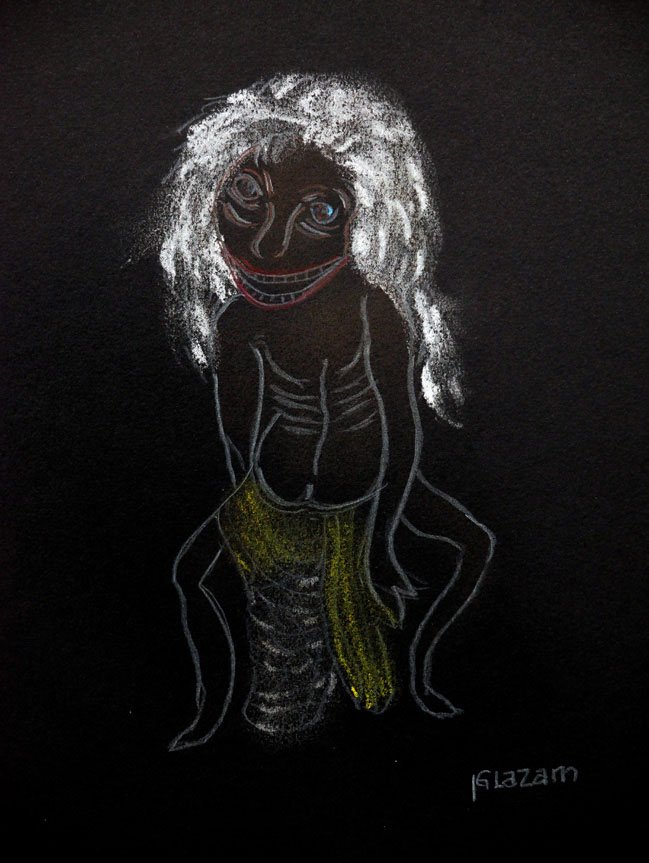
Tambaloslos

Bungisnis

Tigbanua
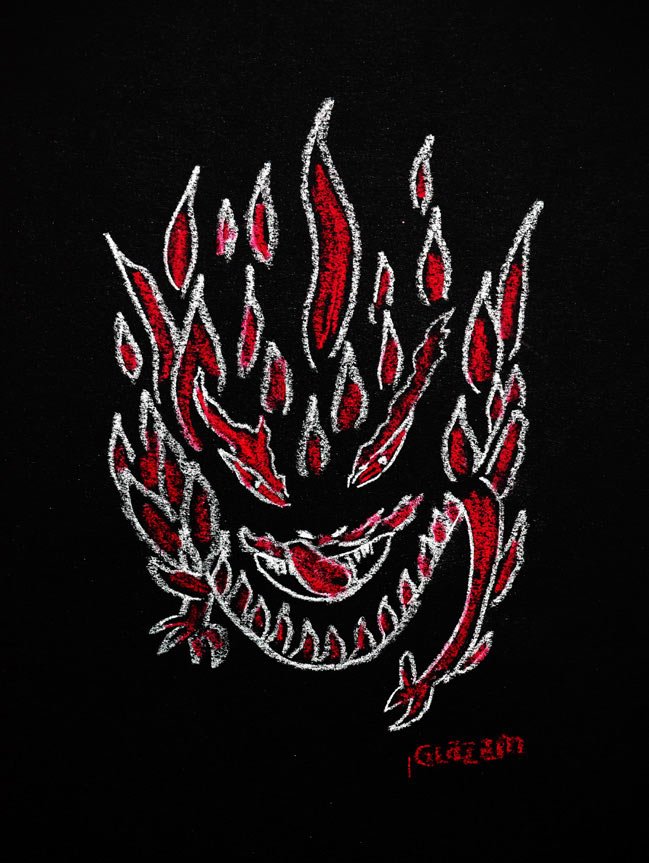
Santelmo
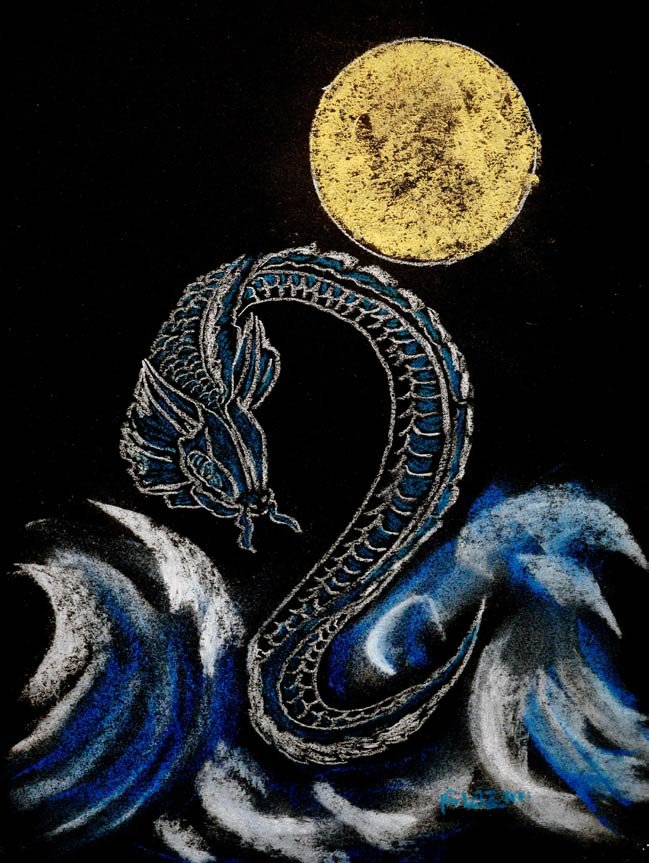
Bakunaua
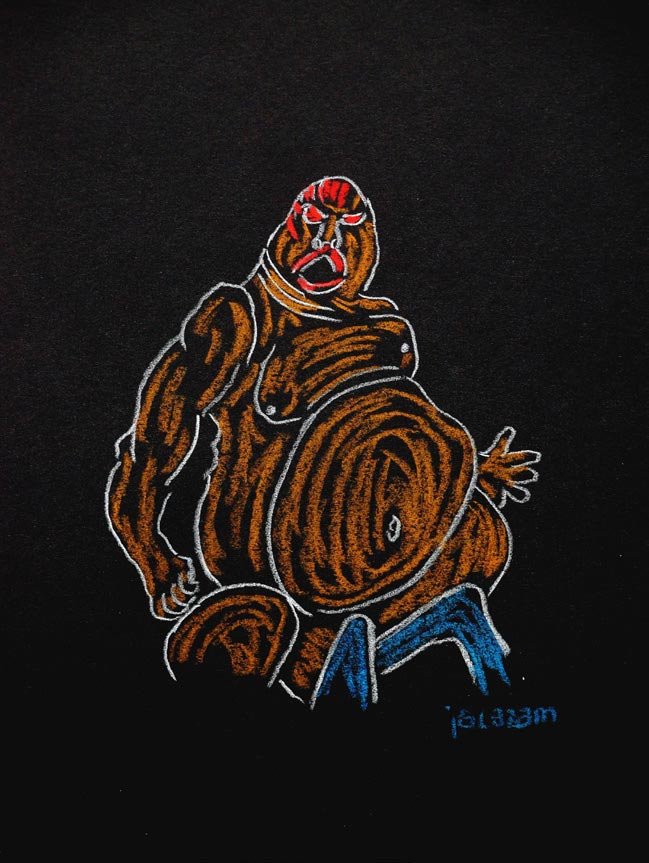
Batibat

The Imprisoned Naga
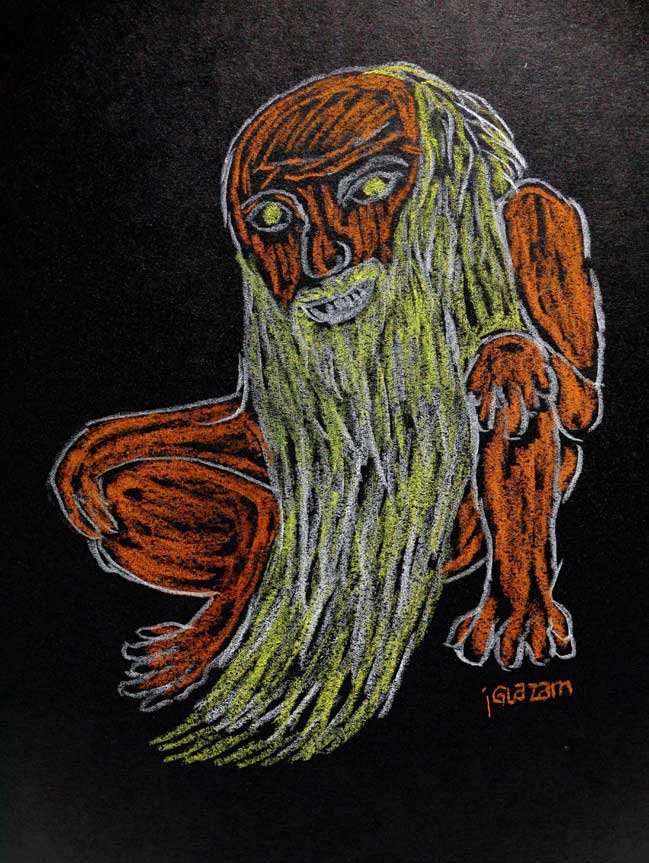
Lampong

Duwende

Aswang

MangKuKulam
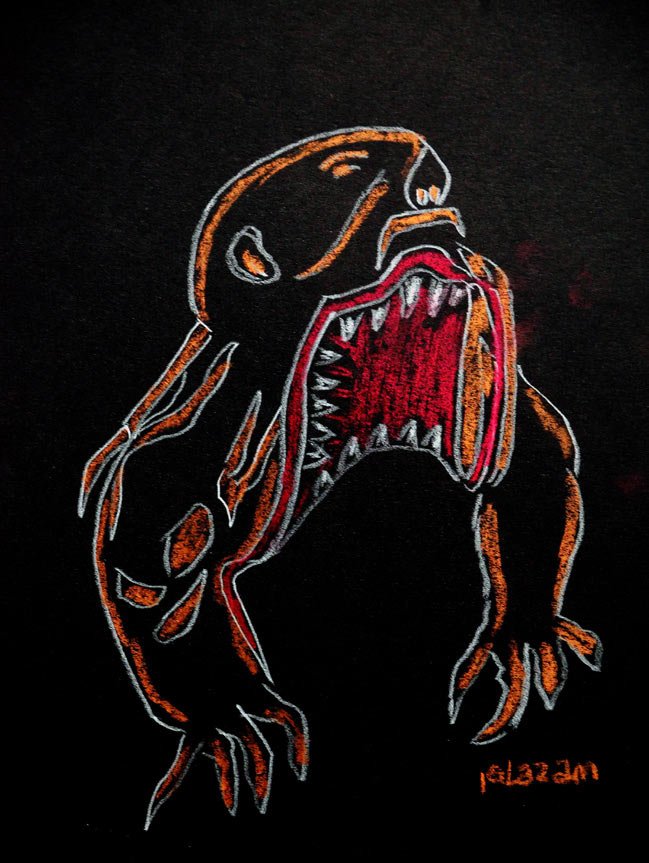
Pugot
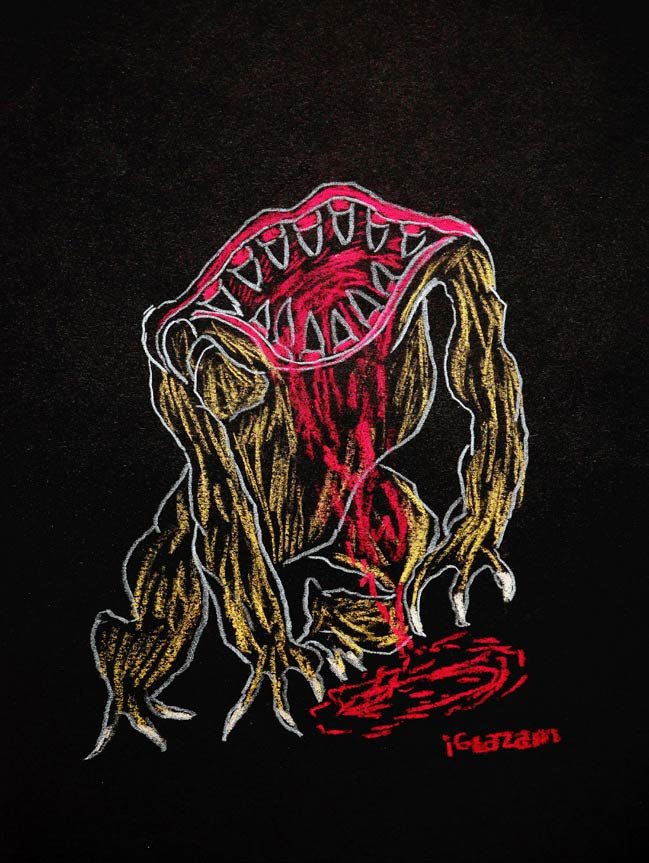
Pugot Mamu
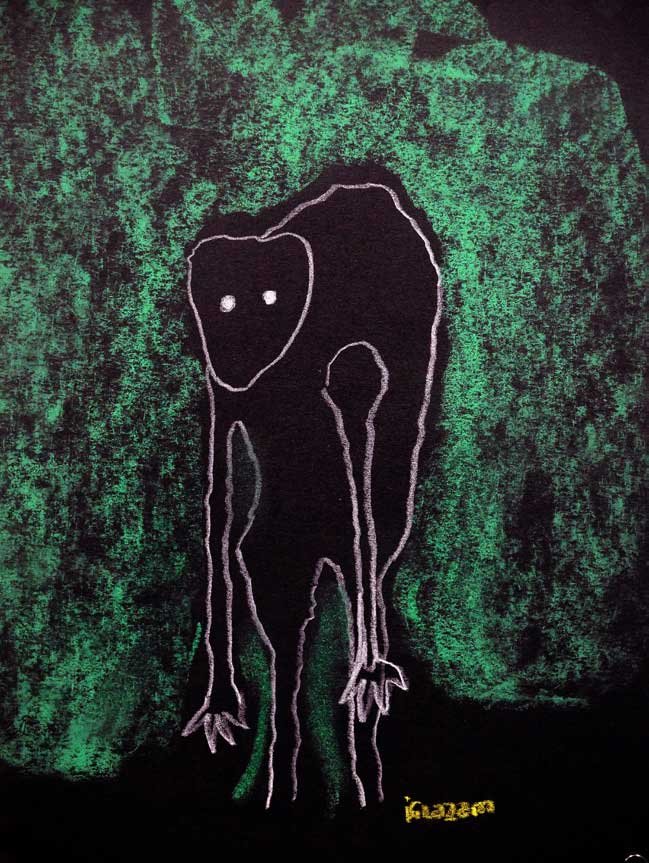
MuMu
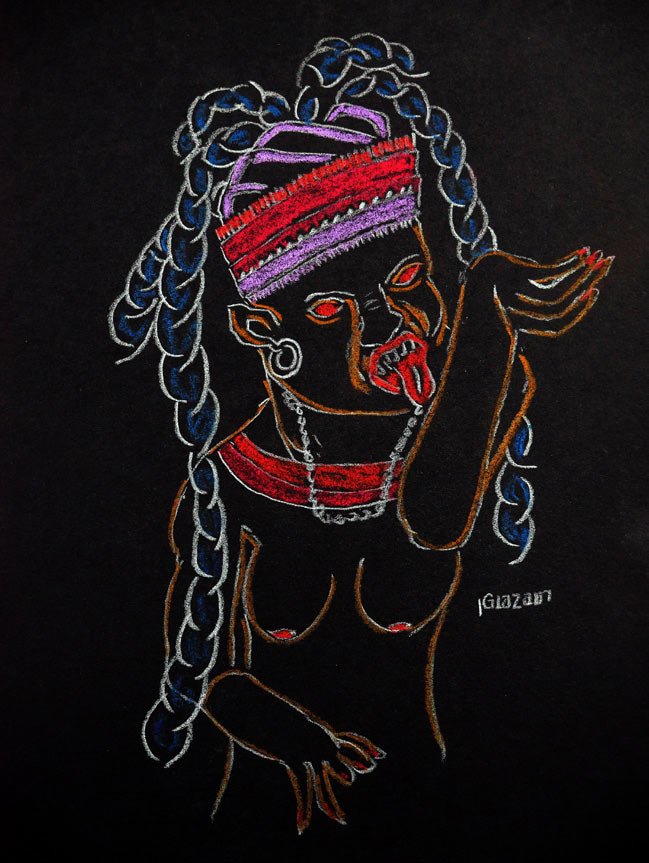
The Danag
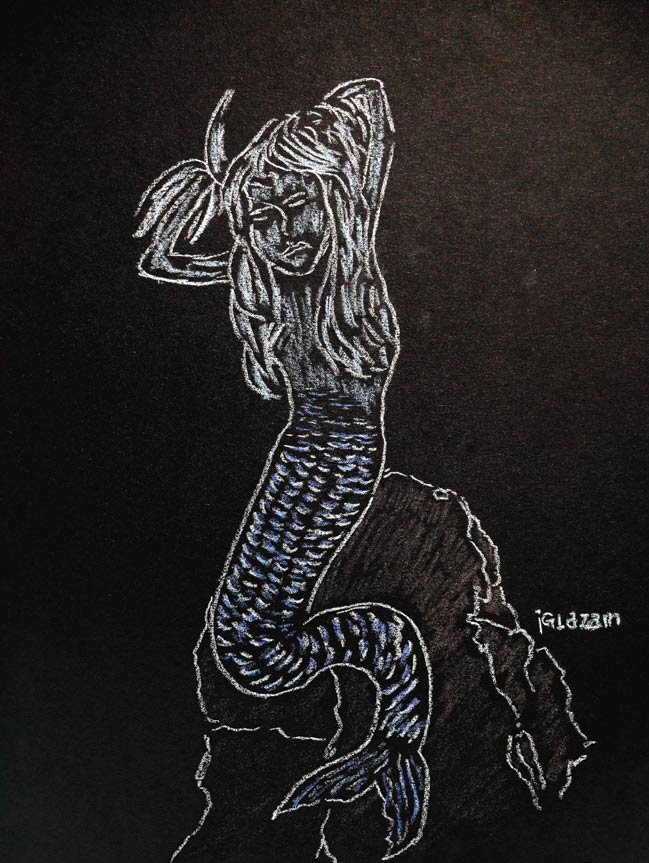
Kataw, Sirens of the Visayas

Mhenamad Thalon

Manalayog
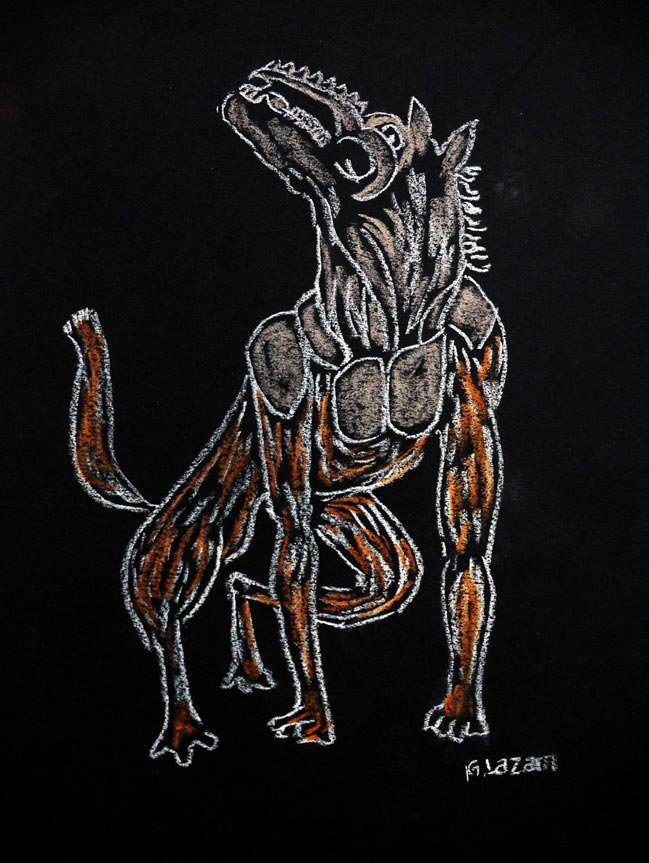
Tikbalang
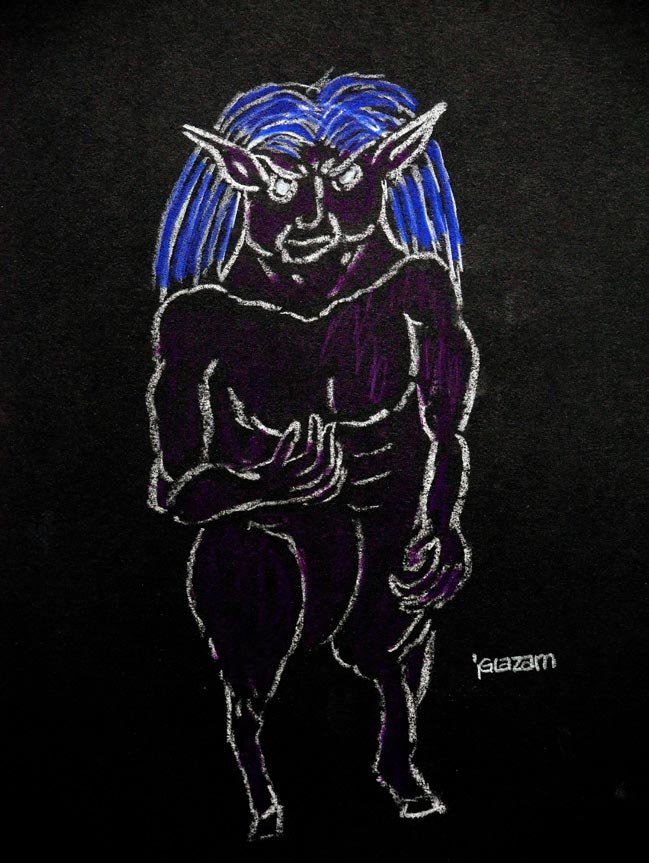
Kabalan
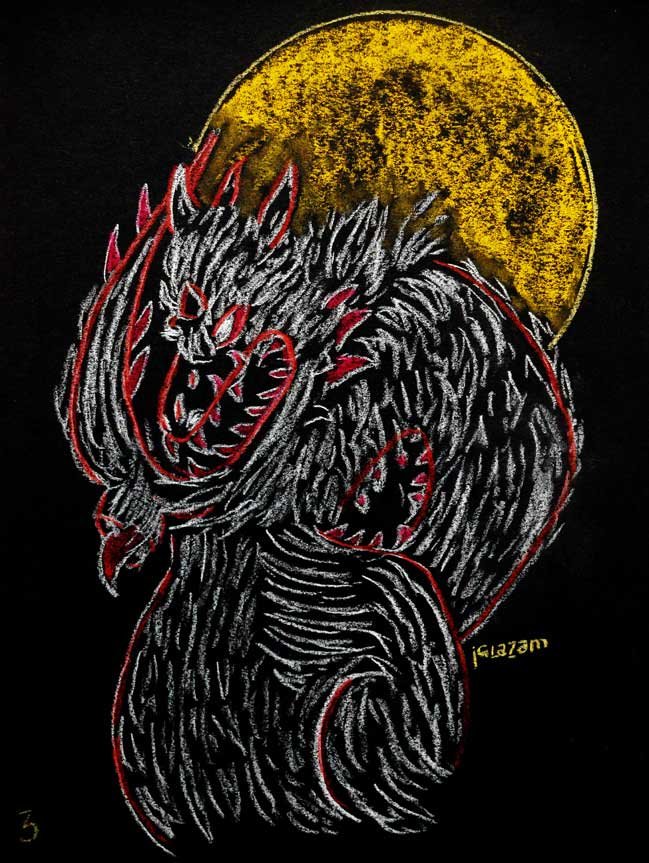
Kedu

MinoKawa
MINDANAO
MAIBALIAN (Bagobo)
The MAIBALIAN are people-generally women past middle life-who through sufficient knowledge of the spirits and their desires, are able to converse with them, and make ceremonies and offerings which will attract their attention, secure their good will, or appease their wrath. They may have crude knowledge of medicine plants, and, in some cases, act as exorcists.
BAYLAN (Bukidnon)
Most traffic with the spirit world is through or with the aid of the BAYLANS—a group of men or women who claim the ability to discover the cause of sickness. They also know how to conduct ceremonies acceptable to the spirits. It is said that the first BAYLAN was taught by Moulin-Olin, the spirit of his after birth brother, who for this reason considered a patron and guide. Two other spirits, Ongli and Donaldson, also appear to the BAYLAN and usually assist in determining the cause of the trouble. The BAYLANS do not form a priesthood, although they are a definite group. Should one of them be visiting in a village where a ceremony is in progress s/he assists as a matter of course.
BALLYAN (Mandaya)
There is in each community one or more persons, generally women, who are known as BALLYAN. These priestesses, or mediums, are versed in all the ceremonies and dances which the ancestors have found effectual in overcoming evil influences, and in retaining the favor of the spirits. They, better than others, understand the omens, and often through them the higher beings make known their desires. So far as could be learned the BALLYAN is not at any time possessed, but when in a trance sees and converses with the most powerful spirits as well as the shades of the departed.
BAILAN (MANOBO, Agusan)
The BAILAN is a man or woman who has become an object is special predilection to one or more of those supernatural friendly beings known among Manobos as DIVATA. This will explain why the word DIUATAHAN is frequently used, especially by the mountain people, instead of BAILAN.
ONITUWAN (Manibo, Mt. Apo)
For the MANOBO people, the unseen world of spirits is as real, if not more so, than the seen or physical world. There are many spirits with MONAMA, the Creatir and obituary spurits, each of whom has been given authority to watch over an area of creation. Spirit mediums ONITUWON allow a spirit to possess them which then becomes their familiar spirit. Then there are a host of spirits, good and bad, residing in the rocks, hills, trees, caves, rivers, and all of nature.
PANTAK, PAMONOLONG, PENDARPAAN (Maranaw)
Mara aw society traditionally believes illnesses are directly or indirectly caused by spirits thatinhabit the world. Magical-curative services are administered by a PANTAK (scorcerer) who injures a persons enemy: GAGAMOTEN ( magical poisoner) charms a loved one with a kata-o sa kababago-i equivalent to a Fatima or lumpy, PAMONOLONG cures corporal sickness and poisoning of an individual through a tawar or prayer or magical spell, and, PENDARPAAN (spirit medium) cures any type of sickness except those determined by fate. Diagnosis of the cause of illness is done first before traditional healers conduct treatment.
KALAMAT (SAMANTHA-BAJAU groups)
Traditional Samantha-Bajau communities may have shamans (dukun) traditionally known as the KALAMAT. The KALAMAT are known in Muslim Samantha-Bajau as the WALI JINN ( custodian of jinn) and May adhere to taboos concerning the treatment of the sea and other cultural aspects. The KALAMAT presides over Sama-Bajau community events along with mediums known as IGAL JINN. The KALAMAT and the IGAL JINN are said to be spirit-bearers, and are believed to be hosts of familiar spirits. It is not, however, regarded as a spirit possession. Religion can vary among the Sama-Bajau subgroups; from strict adherence to Sunni Islam, to forms of folk Islam, to animistic beliefs in spirits and ancestors (umboh) worship.
BATANES AND BABUYAN ISLANDS
MACHANYTU (Ivatan)
Folk herbal medicine has been developed together with the practice of MACHANYTU or calling for assistance of the ANYITUS. His powers are generally regarded as beneficent to good people and threatening to the bad. He can catch thieves and discover the cause of illness and bring their cure by communicating with the invisibles. Healers also go by the names MAMKAW, MASULIB DU DASAL, or MALATIN, MANULIB, and, MAMALAK. In so far as they deal with illnesses it is believed to be caused by invisibles. They are regarded as privileged humans who are not only of the invisible world, but also in possession of powers belonging to, or on the level of, ANYITU.
MINDORO
PADANIWAN (Hanunoo-Manhattan)
The PANDANIWAN is the caretaker/guardian of a good spirit familiar called DANIW. The Mangyan say that the malevolent spirits (LABANG) are human enemies because they eat flesh and blood so that their life principle becomes one of the malevolent spirits. The benevolent DANIW ancestors (apu daniw) help to protect the humans against the LABANGS I’ll intentions. The role of the ritual specialist consists of maintaining the socio-cosmic relations that constitute the system which is based on the apu relation.
Among the Mangyan groups, the terms BALYAN, BALYAN-AN, and TAONG NAGMAMARAYAW are also reportedly used. They also have other names for herbalists and HILOT.
MARINDUQUE
In MARINDUQUE, MAGTATAWAK are known as snake healers. They use various combinations of 150 plant species to create their healing combination of tawak.
The collection of plants and the making of concoctions are done during Holy Week, starting Holy Monday. Preparation is accompanied by cultural traditions, like usal and bulong (incantations) which have been passed down over generations.
Source: Jordan Clark, Director, The Aswang Project
Other Sources:
Garcia, A.L., Ong, E. and Ong, W., 2019. Old legends never die: Philippine mythology in modern times.
February 17.
Rediscovering the Value of Philippine Mythology for Philippine Schools: Literature Review. [online]
Available at: https://ijlls.org/index.php/ijlls/article/view/1057 [Accessed 12 Oct. 2024]
